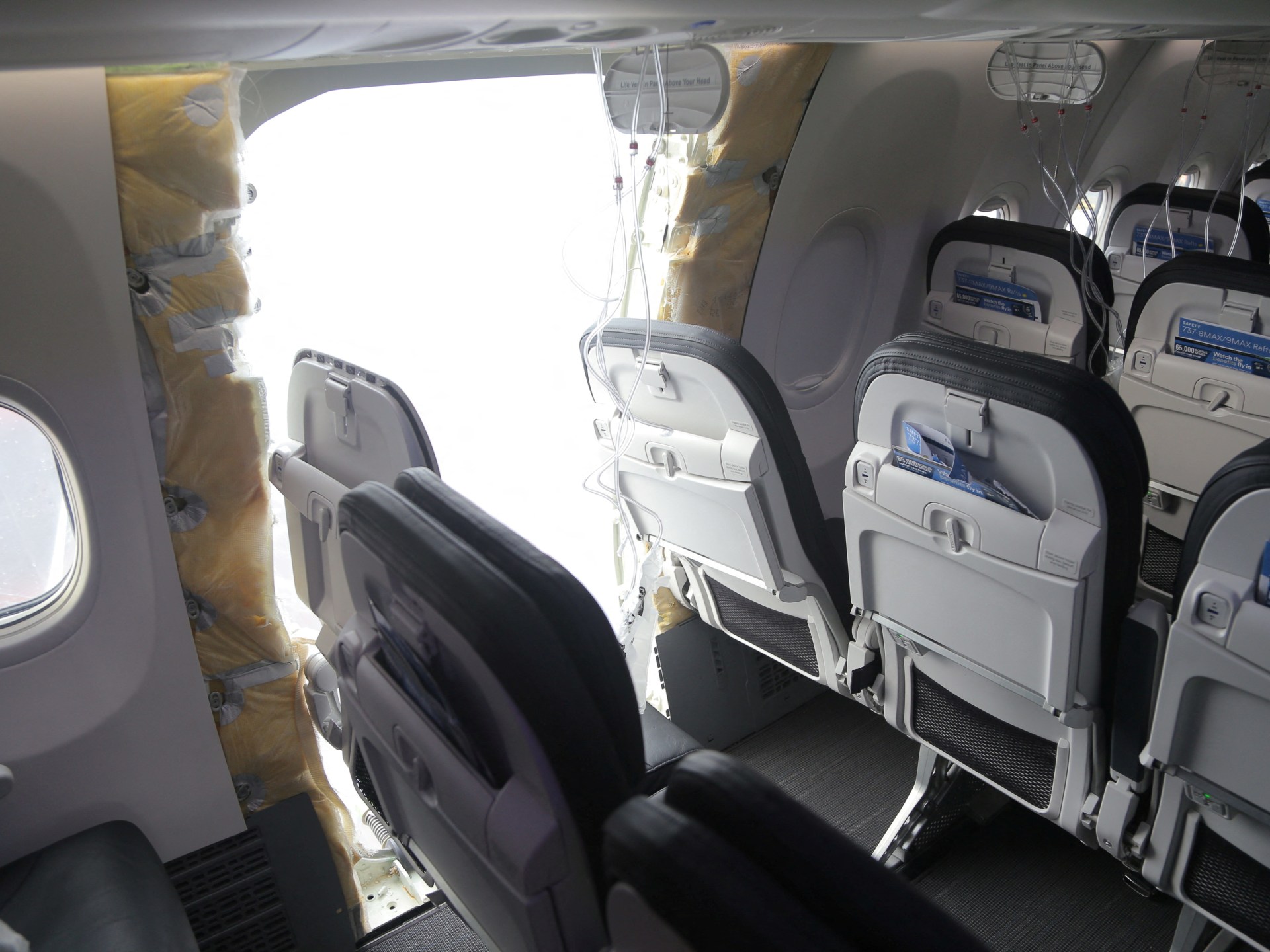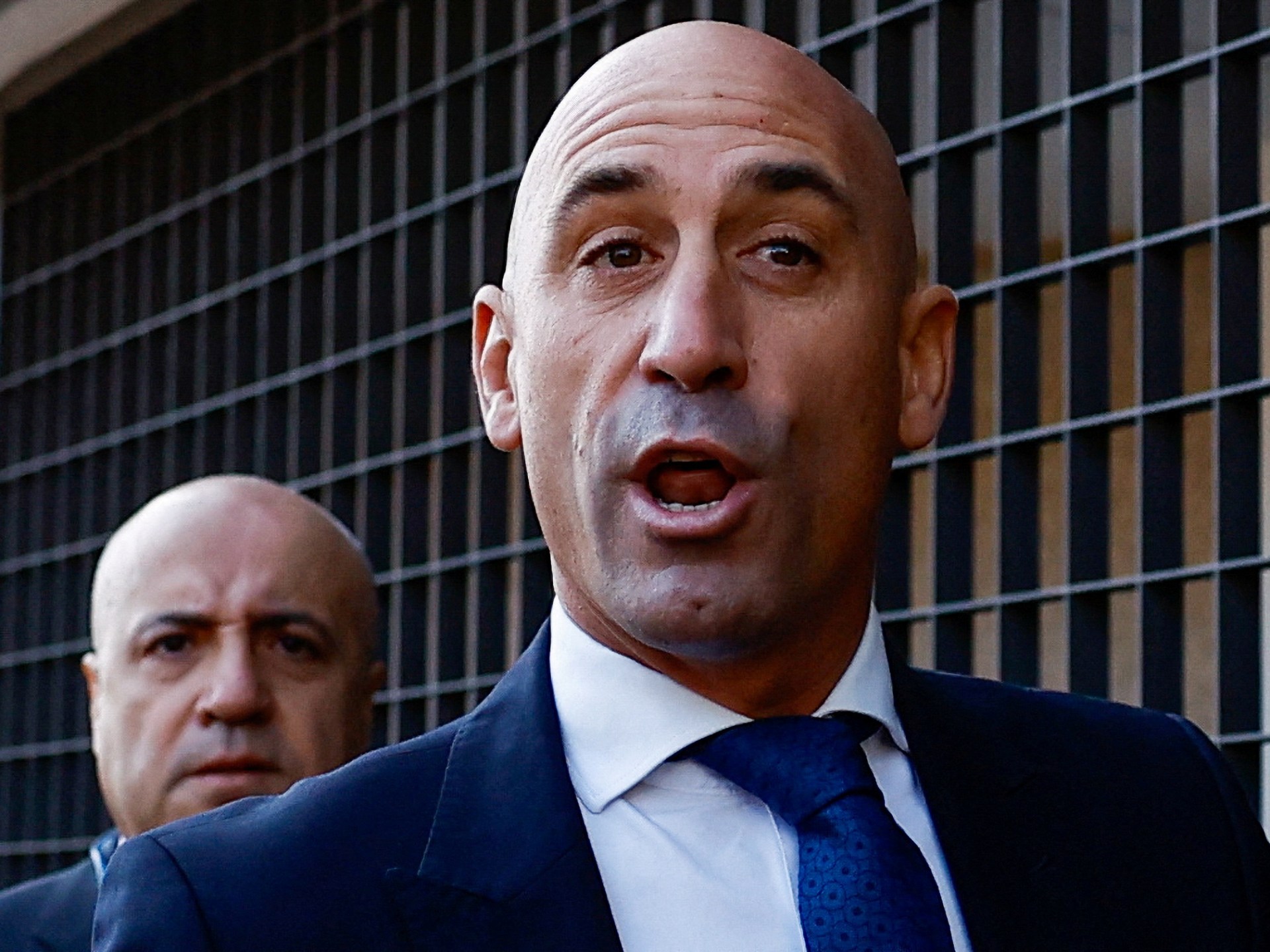What does the Alaska Airlines incident tell us about air safety? | Aviation News
Last week, an Alaska Airlines Boeing 737 Max 9 aircraft was forced to make an emergency landing in Portland, the United States, when a cabin panel blew off in midair leaving a gaping hole in the aircraft’s fuselage. Just days before, a Japan Airways Airbus collided with a smaller coastguard plane, resulting in the Airbus catching fire.
The Federal Aviation Administration (FAA) has ordered an inquiry into the incident and several passengers filed a class action lawsuit against Boeing in Washington state on Thursday.
So, is it really safe to travel by air? Here is what we know about the Alaska Airlines incident and the general safety of aviation:
What happened to the Alaska Airlines flight?
On January 5, just moments after takeoff, a cabin door panel blew off in midair during an Alaska Airlines flight from Portland to Ontario, leaving one side of the aircraft’s body with a gaping hole, reducing cabin pressure and prompting an emergency landing. The blown-out door panel was later discovered by a Portland teacher, in his garden.
Federal officials in the US ordered the temporary grounding of all Boeing 737 Max 9 jetliners until they can be inspected.
The cabin panel that flew out was a “door plug” installed over an extra emergency exit door, which had been removed.
Thankfully, no one was seated next to the gaping hole. Additionally, the plane was only 16,000 feet (4,876 metres) above the ground. Planes typically fly more than 31,000 feet (9,448 metres) when they are at their highest. Had the aircraft been much higher, the pressure difference could have become large enough to suck passengers out of the aircraft, former FAA accident investigator Jeff Guzzetti told The Washington Post.
The aircraft, which had departed from Oregon and was heading for California, landed safely in Portland with all 174 passengers and six crew members mostly unharmed. Some passengers sustained minor injuries.
The aircraft is a new Boeing 737 Max 9 which had been delivered to Alaska Airlines in late October and certified as safe by the FAA in early November. It had been in service for just eight weeks.
London-based independent aviation expert John Strickland told Al Jazeera that the panel which flew off is supposed to be a secure part of the aircraft’s structure. “That’s why it’s more surprising and a matter of concern that this blowout happened,” he said.
London-based aviation analyst and consultant Alex Macheras agreed: “This should not be downplayed, that’s for sure. Because in modern commercial aviation, we do not see sections of an aircraft body, of fuselage, becoming separated from the rest of the aircraft, certainly not mid-flight.”
Has Boeing taken responsibility?
As more than 170 planes remained grounded last week, Boeing CEO Dave Calhoun acknowledged errors made by Boeing and provided reassurance. He told staff that the company would ensure an incident like the Alaska Airlines blowout could never happen again. It has not been confirmed what the actual fault in the aircraft was, although experts told Al Jazeera it is most likely down to a manufacturing flaw rather than a design flaw. There has also been speculation about parts coming loose after both Alaska Airlines and United Airlines reported incidents of needing to tighten loose hardware last Monday.
Earlier, the US chief accident investigator, The National Transportation Safety Board (NTSB), said it had received reports that warning lights had been triggered on brand-new Boeing 737 Max 9 crafts on three flights. Two of these alerts happened on consecutive days before the Alaska Airlines blowout.
Richard Aboulafia, aviation industry analyst and managing director of Washington-based AeroDynamic Advisory, told Al Jazeera that the warning lights were likely the result of a technical glitch. “They ignored it because, strangely, the pressure differential came on while it was on the ground, which means it was a glitch. There’s no pressure differential while you’re on the ground,” he explained. The cabin pressure can only vary when the aircraft is in the air, which is why it was acceptable to ignore the warning and fly the plane over land, he said.
The company stopped flying the aircraft over the Pacific Ocean to Hawaii due to the warnings, yet kept it flying over land, the NTSB said.
Who checks the safety of an aircraft?
Aboulafia explained that the FAA typically certifies an aircraft, approving its operations and production.
However, since the Boeing 737 Max has had safety issues before, the FAA announced that it would inspect every single aircraft in the Max series under these unusual circumstances. The details about the exact checks that were carried out are not public.
Once the aircraft is in use by an airline, regular maintenance checks called A, B, C and D checks are carried out, Aboulafia explained. While an A check is typically a cursory investigation of a plane’s moving parts, exterior wear and tear and of oil and fuel, a D-check is rigorous and involves a teardown and detailed inspection of the aircraft.
These checks are carried out at dedicated intervals based on the number of years an aircraft has been in service or its number of flight hours. Some airlines have their own in-house capabilities to carry out these checks and while many airlines are able to do A or B checks, only certain airlines are able to do C or D checks themselves. Others use third-party services.
“This is an unprecedented production ramp and, clearly, there needs to be more resources provided for it, whether it’s at the manufacturing level or the inspections level,” Aboulafia added, referring to how aeroplanes are now manufactured in large numbers. He called for a greater number of people to be assigned more time for inspections.
Aboulafia added that it is imperative to identify where and how the Alaska aircraft passed its safety checks, and whether it was Boeing, Spirit Aerosystems or the FAA that cleared the jetliner without detailed inspection. There is no information about the level of detail of inspection that took place before the plane was cleared for flying.
At some or at multiple stages in the process, there needed to be more time allowed for workers or inspectors to “do their job”, however, Aboulafia said, adding: “We don’t know yet, but clearly, there was a gap in how things should have been done.”

Have Boeing 737 aircraft had problems before?
Yes. The jets were grounded worldwide for about two years after a crash killed 189 people in Indonesia in October 2018 and another killed 157 in Ethiopia five months later.
In both instances, a design flaw was found in the automated flight control software, which activated erroneously. Boeing 737s were cleared to fly again once the aircraft had been revamped with an improved flight control system.
Aboulafia said the crashes in Indonesia and Ethiopia had been caused by design defects in the flight control system, while the recent incident was a defect in manufacturing, with loose hardware on aircraft, however.
United Airlines and Alaska Airlines have both reported loose hardware that needed additional tightening on multiple grounded Boeing 737 Max 9 aircraft on Monday, raising new concerns among industry experts about the manufacturing process.
If a design issue occurs, the design defect must be fixed on the aircraft before the plane model is cleared to fly again, he explained.
For manufacturing defects, “you have to identify where the mistakes were made, and then it’s an easy inspection, especially since it’s structural rather than software or anything like that”, he added.
Why is turbulence on the rise?
A June 2023 study by the UK’s Reading University showed that severe air turbulence had increased by 55 percent at an average point over the North Atlantic between 1979 and 2020.
The study concluded that turbulence will become worse with climate change, and the calculated rise is consistent with the expected effects of changes in climate. Hence, the rise in turbulence is not due to poor design or the manufacturing of aircraft.
Is air travel still the safest mode of transportation?
Harvard University research has found that the odds of being in a plane crash are one in 1.2 million, while the odds of dying in such a crash are one in 11 million. Meanwhile, the odds of dying in a car accident are significantly higher at one in 5,000.
“Is any form of transport always safe? No, but if you choose not to fly and instead take a car, that’s a far more dangerous way of travelling,” said Aboulafia.
Check out our Latest News and Follow us at Facebook
Original Source







